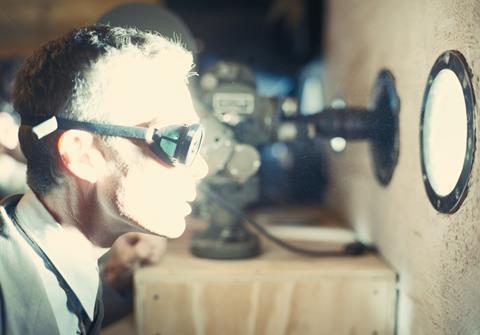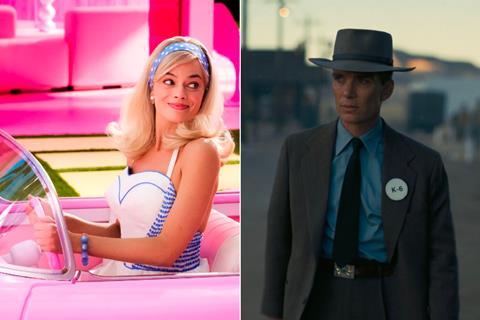
Tom Cruise may have “saved Hollywood’s ass” in 2022 (as Steven Spielberg famously put it to the star of monster hit Top Gun: Maverick), but 2023’s North American summer box office was saved by two less-likely candidates. Before Barbie and Oppenheimer opened over the same July 21 weekend, summer box office in North America was 7% down on the summer of 2022 at the same stage and 15% behind the pre-pandemic summer of 2019, according to figures from Comscore.
By August 21, however, after the second biggest July in domestic box-office history, summer 2023 was 16.6% ahead of last year and 5.3% behind summer 2019. At time of writing, with less than two weeks before its official end with the US’s September 4 Labor Day holiday, the domestic summer season was on course to reach — for the first time since before the pandemic — $4bn.
The season’s highest-profile hits impressed with more than just their box-office totals. Barbie, which as of August 22 had cruised to $569.4m domestically (and more than $1.28bn globally) to become Warner Bros’ biggest North American release ever and is on track to overtake The Super Mario Bros. Movie ($574.3m) any day now to become the highest grossing film of the year to date, also drew a particularly eager and desirable audience.
According to film data firm Movio, 43% of the film’s opening weekend crowd were infrequent cinemagoers, meaning they had made fewer than two visits in the past six months. And according to online ticket seller Fandango, 27% of its Barbie orders have been for three or more tickets, illustrating what The Wall Street Journal described as the “women’s multiplier effect” in movie and concert ticket sales.
Jeff Goldstein, Warner Bros Pictures’ president of domestic distribution, reports the film’s audience was initially about 65% female but broadened out to an even female‑male split in the weeks after the opening. “This is a movie that made people smile and laugh regardless of their geopolitical background, their ethnic background, their geographic background,” says Goldstein. “This is a movie that just united people.”
Premium quality

Universal’s Oppenheimer, which by August 21 had reached $285.3m domestically (and $718.6m globally) in spite of its darker themes and three-hour running time, started with a general audience that was 62% male and, according to Movio, 36% infrequent moviegoers. It also drew a particularly big audience to the Imax and other premium large-format screens that the studio emphasised in its release strategy. With a film that Universal Pictures president of domestic theatrical distribution Jim Orr says “really should be seen not only on the big screen but in the most immersive format possible,” that strategy “paid off handsomely”.
Then, of course, there was the ‘Barbenheimer’ effect. Believed to have originated in a Twitter post more than a year ahead of the films’ release, the melding of the two titles into the #barbenheimer hashtag started a fan-generated internet craze, spawning unofficial merchandise and encouraging potential ticket-buyers — most crucially those in younger demographics — to see both films on opening weekend. Though never officially endorsed by Warner Bros or Universal, the Barbenheimer phenomenon was picked up by some of the talent involved and by at least one major US exhibitor.
It is not easy to calculate Barbenheimer’s economic effect, but Movio reports that 10% of early Barbie viewers also saw Oppenheimer on opening weekend — which could have accounted for 19% of the latter’s $82m debut take — and that 17% of Oppenheimer attendees also caught Barbie — perhaps contributing 9% to that film’s $162m haul.
Universal’s Orr suggests the phenomenon also had a wider effect on the marketplace and the moviegoing public. “It elevated the entire theatrical experience, as well as these two films,” Orr says. “It reminded people of how special it is to be in theatres, how the communal aspect of being in theatres can never be replicated at your house no matter how great your big-screen TV might be.”
The marketplace could do with some elevation, judging by the performances of some of the other entries on Comscore’s North American top 30 chart covering the period May 5-August 14. The summer did produce one other unqualified smash, in Sony’s early June animated release Spider-Man: Across The Spider-Verse, which doubled the $190m take of its 2018 predecessor Spider-Man: Into The Spider-Verse, grossing $380.9m to date. And in child trafficking drama Sound Of Freedom, with more than $178m from its early July launch through Angel Studios, the season produced a major surprise credited with tapping into North America’s underserved faith-based and conservative audience.
Missing links

The season’s most obvious miss was Warner Bros’ mid-June entry The Flash, whose $108.1m fell well short of expectations for the DC Extended Universe entry. A number of major summer releases, though, fell into a middle ground occupied by familiar properties producing solid but not spectacular box-office numbers. Disney/Marvel’s Guardians Of The Galaxy Vol. 3 was behind the franchise’s second volume but ahead of its first, with $359m; Disney’s The Little Mermaid took $297.2m but did not come close to the studio’s most successful live-action remakes; Disney/Pixar’s Elemental picked up after a slow start, but its $151m was well short of pre-pandemic Pixar standards; and Universal’s Fast X, with $146m, was the weakest instalment of the long-running Fast & Furious franchise since 2001.
Disney’s Indiana Jones And The Dial Of Destiny (with $172.8m), Paramount’s Mission: Impossible — Dead Reckoning Part One ($164.6m) and the same studio’s Transformers: Rise Of The Beasts ($157.1m) were all “expensive movies — made more expensive by pandemic delays — that did not do the kind of business they were expected to do”, says David A Gross, who runs movie consultancy Franchise Entertainment Research.
Summer often leaves space for a handful of specialty films at the North American box office and this year, A24’s Sundance romantic drama Past Lives hit the $10m benchmark while the indie studio’s horror thriller Talk To Me (launched the weekend after Barbie and Oppenheimer) had reached an impressive $37.4m by August 21. Focus Features’ Asteroid City, fresh from its Cannes premiere, gave indie darling Wes Anderson another solid summer hit with its $27.9m. It also illustrated, suggests Focus’s president of distribution Lisa Bunnell, how the specialty sector is evolving in the post-pandemic world.
“We are starting to get younger audiences in — younger people who are appreciating directors like Wes Anderson taking them to the next level,” says Bunnell. “So we are trying to market more towards a whole new specialty crowd, along with the classic crowd.”
How the marketplace is evolving may be one of the lessons to be learned from summer 2023. Franchise Entertainment’s Gross suggests the performances of Barbie, Oppenheimer, Asteroid City and Talk To Me, as well as the summer’s less impressive franchise films, show that “originality and strong filmmaker points of view are winning the day. More of the same, alone, is not enough.”
Maintaining momentum

But perhaps the bigger question now is whether the Barbenheimer effect will fade as the summer box-office season winds down or persist and create momentum for other titles. Comscore senior media analyst Paul Dergarabedian sees the cumulative box-office effect of Barbie and Oppenheimer as “a unique situation”, adding: “That combination is very much an outlier.”
By exposing cinemas full of people to trailers and marketing for future releases, the two unlikely summer smashes “could theoretically be the tide that lifts all boats”, Dergarabedian concedes. “But if the appeal of those other movies is not there, it’s only going to get you so far.”
Marketers and distributors, however, appear optimistic that Barbenheimer will have a lasting effect on the domestic box-office climate. A recent survey by film tracking and research company The Quorum showed 40% of a sample of 1,800 Barbie ticket buyers reporting the experience of seeing the film “reminded me how much I like going to the theatre”, and that they would now be “going more often”.
Universal’s Orr believes that “when something comes along that is this exciting, it brings a lot of people back into theatres.” Now, says Orr, “we have some momentum that will help us into the future.”
That momentum could be especially valuable during an autumn awards season in which distributors and marketers may not, if the US actors strike remains in effect, have access to on-screen talent for promotional purposes. Focus Features’ Bunnell, now planning for the October 27 domestic launch of director Alexander Payne’s The Holdovers (after the international premiere of the Paul Giamatti comedy drama at Toronto), suggests the autumn season will give rise to “outside-the-box” marketing moves.
“You’re going to see people doing some new and innovative things and hopefully we all learn something from this that expands what we can do in the future,” says Bunnell. The effort will be assisted, the Focus executive believes, by this summer’s box-office phenomenon. “[The Barbenheimer effect] is one of the best things that’s happened to the industry in a long time. It will carry the box office into a much better place.”






![The Brightest SunScreen[Courtesy HKIFF]](https://d1nslcd7m2225b.cloudfront.net/Pictures/274x183/3/5/0/1448350_thebrightestsunscreencourtesyhkiff_312678.jpg)


















No comments yet